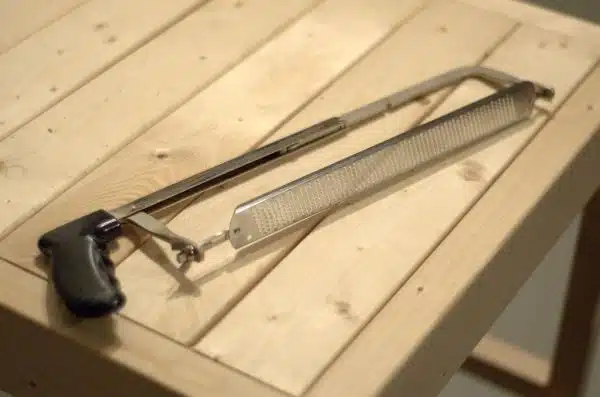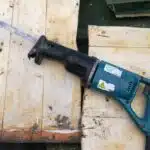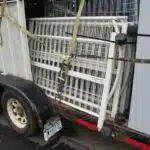Hacksaws are an essential tool in any handyman’s toolkit. These saws allow for the efficient cutting of metal, plastic, and wood. Their unique design allows for versatility in the cutting process and the ability to cut through even the toughest materials. As a hacksaw specialist, it is important to understand what a hacksaw is and how to use it properly.
A hacksaw consists of a frame with a blade that is under tension. The blade can be replaced when it becomes dull or damaged, making maintenance easy. The handle of the saw provides a comfortable grip while using it and allows for precise control over the cutting process. Understanding the basic anatomy of a hacksaw is crucial in utilizing its full potential. In this article, we will explore what a hacksaw is and provide step-by-step instructions on how to use it effectively.
The Anatomy Of A Hacksaw
A hacksaw is a hand tool commonly used in cutting through metal, plastic, and wood. It consists of a frame, handle, and blade. The frame provides stability to the blade while the handle offers a comfortable grip for the user. The blade is interchangeable, meaning it can be removed and replaced depending on the material being cut.
Hacksaw maintenance is essential to ensure that it functions optimally and lasts longer. One of the ways to maintain a hacksaw is by cleaning it after every use. This helps to remove any debris or particles that might have accumulated on the blade during cutting. Additionally, lubricating hacksaw blades with oil or wax can prevent rusting and extend their lifespan.
Lubricating hacksaw blades involves applying oil or wax along the teeth of the blade before use. This helps to reduce friction between the blade and material being cut, resulting in smoother cuts and less wear on the blade. It’s important to note that using too much lubricant can cause clogging of teeth, resulting in slower cutting speeds. Therefore, it’s recommended to apply just enough lubrication for optimal performance.
Proper knowledge of hacksaws’ anatomy enables smooth operation during usage; however, using an appropriate type of saw blade enhances productivity in results achieved during cutting tasks; hence attention should be given when choosing which type of saw blades should be used for which materials being cut through.
The Different Types Of Hacksaw Blades
Transitioning from the anatomy of a hacksaw, it is time to delve into the different types of hacksaw blades. The type of blade you choose for your hacksaw will depend on the material you are cutting and the desired finish. It is important to select the right blade for the job to achieve optimal results.
One of the most common types of blades is a carbon steel blade. These blades are affordable and can cut through soft materials such as wood or plastic with ease. However, they tend to dull quickly when cutting through harder materials like metal. Another type of blade is high-speed steel, which has a higher resistance to heat and wear than carbon steel blades, making it more suitable for cutting through harder materials.
Additionally, there are also bi-metal blades that combine two types of metals; high-speed steel teeth and a flexible carbon steel back. These blades offer durability and flexibility, making them ideal for use in heavy-duty applications. However, these blades come with higher price tags compared to other types because they typically last longer.
In choosing the right hacksaw blade for the job, it is important to consider factors such as material type and thickness, as well as desired finish quality. Keep in mind that using the wrong type of blade may result in damage not only to the saw but also to your workpiece. Understanding the advantages and disadvantages of each type of hacksaw blade can help you make an informed decision when selecting one for your project needs.
Transitioning into choosing the right hacksaw blade requires careful consideration based on various factors related to material type and thickness desired finish quality among others.
Choosing The Right Blade For The Job
Blade selection is crucial when it comes to getting the most out of your hacksaw. The thickness and material of the blade play a significant role in determining its suitability for specific jobs. While thicker blades are generally sturdier, they require more effort to use. Thinner blades, on the other hand, are easier to maneuver and ideal for finer cuts.
When it comes to selecting the right blade material, there are two options available: high-speed steel (HSS) and carbon steel. HSS blades are known for their durability and ability to retain their cutting edge for longer periods. They’re ideal for cutting through hard materials like stainless steel and cast iron. Carbon steel blades, on the other hand, are cheaper than HSS blades but not as durable. They’re an excellent choice for softer materials like wood and plastic.
In summary, choosing the right blade thickness and material is vital when looking to get the most out of your hacksaw. For tougher materials, go with a thicker HSS blade that can withstand prolonged use without dulling quickly. For softer materials like wood or plastic, thinner carbon steel blades will suffice. By making an informed decision about your blade selection, you’ll save time and effort while producing quality results.
- Don’t compromise on quality by using inferior blades
- Choose a thicker blade for tougher materials
- Opt for a thinner blade when precision is required
- Always choose high-quality materials
- Make sure your blade selection matches your job requirements – Regularly maintain and sharpen your blades to ensure optimal performance and prolong their lifespan.
Safety Precautions When Using A Hacksaw
As you prepare to use a hacksaw, it is important to prioritize safety in all that you do. One of the most important safety measures is wearing eye protection at all times – without proper eye protection, flying metal shavings or debris can cause permanent damage to your vision. Additionally, it is crucial to avoid common mistakes such as applying too much pressure or attempting to saw through materials that are too thick for your blade. These mistakes can lead to broken blades, increased risk of injury, and a subpar finished product.
When it comes to using a hacksaw safely, prevention is key. Before beginning any cuts, make sure that your work area is properly lit and secure. Ensure that you have enough space to move freely and that there are no tripping hazards nearby. When ready, use controlled strokes with just enough pressure to keep the blade moving smoothly through the material. With these precautions in place, you can minimize the risk of accidents while achieving accurate cuts every time.
In order to make the most of your tools and improve your overall safety while using them, it’s important to be aware of common mistakes and take steps towards avoiding them at all costs. By prioritizing eye protection and taking care when making each cut, you can prevent accidents and ensure that your finished product meets all necessary standards for quality and accuracy. In the next section, we will explore how best to prepare materials before cutting with a hacksaw – an essential step in ensuring top-notch results every time.
Preparing The Material To Be Cut
Before you start sawing, it is essential to prepare the material you are going to cut. This step will help you achieve accurate results and prevent the material from being damaged. To do this, marking the material is crucial. You can use a pencil or marker to mark the area where you want to make the cut.
When marking, ensure that your markings are visible and precise. Make sure they are straight and in line with your intended cut. Doing this will help to guide your sawing process and prevent mistakes that could result in inaccurate cuts.
Now that your material is marked correctly, it’s time to consider the sawing technique you will use. There are various sawing techniques but choosing one that aligns with your skill level and project needs is important. Common sawing techniques include push stroke, pull stroke, backstroke, and crosscutting. Choose a technique that works for you and ensure that you maintain a consistent rhythm as you work.
As we have seen in this section, marking the material correctly and selecting an appropriate sawing technique are vital steps when preparing for a hacksaw project. Next, we’ll take a look at ensuring that your hacksaw blade is tight and secure before starting to cut.
Ensuring The Hacksaw Blade Is Tight And Secure
Adjusting the tension of a hacksaw blade is critical for ensuring efficient and safe operation. The tension of the blade should be adjusted to the level necessary for the material being cut and the type of blade being used. To secure the hacksaw blade, it should be securely clamped into the hacksaw frame to prevent slipping and ensure accurate cutting. Finally, it is important to regularly check the tension of the blade to ensure that it is properly secured and functioning optimally.
Adjusting The Tension
One of the most important things to remember when using a hacksaw is to ensure that the blade is tight and secure. This helps to prevent accidents and ensures that you can make accurate cuts. Adjusting hacksaw tension is a crucial step in achieving this.
The importance of proper blade tension cannot be overstated. When the blade is too loose, it can wander off course, making it difficult to cut straight lines. On the other hand, if the blade is too tight, it can become brittle and break easily. Finding the right balance between tightness and looseness is key to maintaining a sharp and effective hacksaw.
To adjust the tension on your hacksaw, start by loosening the wing nut or screw that holds the blade in place. Then, use your fingers or pliers to tighten or loosen the tensioning screw on the handle of the saw. Be sure to test your adjustments by making a few practice cuts before starting your project. By taking these simple steps, you can ensure that your hacksaw is properly adjusted and ready for use whenever you need it.
Securing The Blade
Maintaining a hacksaw is crucial in ensuring its longevity and effectiveness. One of the most important aspects of hacksaw maintenance is blade maintenance. Keeping the blade sharp and properly secured can greatly improve the accuracy and efficiency of your cuts. In this article, we will discuss how to secure the blade on a hacksaw.
To secure the blade on a hacksaw, start by ensuring that it is tightly fastened to the saw frame. Loosen the wing nut or screw that holds the blade in place, then carefully insert the blade into the frame. Tighten the wing nut or screw until it feels snug but not overly tight. Next, check to make sure that the teeth of the blade are facing forward and pointing away from you. This will ensure that you are cutting in the correct direction.
After securing the blade, it is essential to keep it sharp for optimal performance. Sharpening techniques may vary depending on personal preference, but generally involve using a sharpening stone or file to remove any dullness or nicks on the teeth of the blade. Regularly inspecting and maintaining your hacksaw blade will not only improve its lifespan but also enhance your overall sawing experience.
Proper Hand Placement And Grip
Proper Hand Placement and Grip are essential when using a hacksaw. The correct hand placement can help you maintain proper posture and reduce the risk of injury. To achieve optimal hand placement, it is best to hold the saw with both hands, ensuring a firm grip on the handle. Your dominant hand should be placed on the handle’s top, while your other hand should be positioned under the saw’s frame.
Maintaining proper posture when using a hacksaw is crucial to ensure accuracy and precision in your cuts. Stand with your feet shoulder-width apart, keeping your weight evenly distributed over both legs. Keep your back straight and avoid leaning forward or backward while sawing. This position helps provide stability and control over the saw.
The Sawing technique is integral to achieving a smooth cut without damaging the material being cut or injuring yourself. Always start by aligning the blade perpendicular to the surface you are cutting. Use slow, steady strokes while applying moderate pressure to create an even cut. Avoid forcing the blade or twisting it during use as this may cause it to break or bend, resulting in an uneven cut or potential injury.
Starting The Cut
Like a painter’s brush to a canvas, the hacksaw blade glides through metal with precision and finesse. Starting the cut is an essential step in this process and requires patience, skill, and practice. Before proceeding, ensure that you have taken all necessary safety precautions, such as wearing protective gear like gloves and eye goggles.
To begin the cut, place the saw blade on the material at a 45-degree angle. Apply slight pressure to start a groove in the metal; this will guide your saw blade as you continue cutting. Once you’ve created this groove, adjust your grip on the saw handle to increase pressure gradually while maintaining control over the blade’s path.
Common mistakes during this stage include exerting too much force or not keeping a consistent angle throughout the cut. If you encounter these issues, troubleshooting tips include adjusting your grip or taking breaks to reposition yourself before continuing. Remember that starting a cut is just one part of using a hacksaw correctly – it takes time and attention to detail to achieve optimal results. In the following section, we will discuss how to maintain the right amount of tension on the blade for effective cutting.
Maintaining The Right Amount Of Tension On The Blade
Maintaining blade tension is crucial when using a hacksaw. The right amount of tension on the blade ensures that it cuts through materials with ease and efficiency. Too much or too little tension can cause the blade to break or become dull quickly.
To maintain proper blade tension, start by checking the manufacturer’s specifications for your particular hacksaw model. Then, use a tensioning tool to adjust the blade to the recommended level. A good rule of thumb is to tighten the blade until it makes a clear, musical sound when plucked.
In addition to maintaining proper blade tension, it’s important to keep the blade lubricated during use. This helps reduce friction and prevent premature wear and tear on both the blade and saw frame. Apply a small amount of lubricant directly onto the teeth of the blade before each use for optimal performance. Remember, proper maintenance keeps your hacksaw in top shape and ready for any cutting job that comes your way.
Transition: Now that you know how to maintain proper blade tension and lubrication, let’s move on to another important aspect of using a hacksaw: keeping the blade straight and level.
Keeping The Hacksaw Blade Straight And Level
Maintaining the right amount of tension on the hacksaw blade is crucial for achieving precise cuts. However, this is not the only factor that contributes to accurate cuts. Keeping the hacksaw blade straight and level is equally important.
To ensure that you make straight cuts, start by positioning your body in a way that allows you to have a clear view of the workpiece. Stand with your feet shoulder-width apart and position yourself so that you’re directly in front of the area where you’ll be cutting. This will help you maintain control over the saw and keep it aligned with your cutting path.
Common mistakes when using a hacksaw include applying too much pressure, failing to hold the saw steady, and not aligning the blade correctly. If you encounter any of these problems, try troubleshooting tips such as adjusting your grip or repositioning yourself to get a better view of your workpiece. Improving precision takes practice exercises such as cutting along a straight line or using a guide to ensure accuracy.
Transition into subsequent section: “Now that we’ve covered how to keep the hacksaw blade straight and level, let’s move on to making straight cuts.”
Making Straight Cuts
To make straight cuts with a hacksaw, you need to first ensure that the blade is properly tensioned. A loosely-tensioned blade will not cut efficiently and may even break during use. To tighten the blade, simply rotate the adjustment knob on the saw frame until it feels taut.
Next, position yourself and the material you’re cutting in a stable manner. It’s important to keep your body steady while using a hacksaw because any sudden movements can cause the blade to slip or break. Additionally, make sure that the material is securely clamped down or held in place so that it doesn’t move around during cutting.
Common mistakes when making straight cuts include applying too much pressure on the saw, which can cause unnecessary wear on both the blade and saw frame. It’s also important to avoid angling the saw as this can lead to crooked cuts. Finally, remember to let the blade do the work – don’t try to force it through thicker materials as this could also cause damage.
Advanced techniques for making straight cuts include using a guide or template to ensure precise measurements and angles. Additionally, some hacksaws come with adjustable blades which allow for angled or beveled cuts. These techniques require more skill and experience but can produce impressive results.
Moving onto making curved cuts…
Making Curved Cuts
When it comes to making curved cuts with a hacksaw, precision is key. It’s essential that each cut is made with accuracy and attention to detail so that the end result is exactly what you intended. To achieve this level of precision, using a jig can be incredibly helpful. A jig is essentially a template or guide that helps you create consistent and accurate cuts.
Another technique for making curved cuts with a hacksaw is sawing circles. This method involves drilling a hole in the center of your workpiece and then inserting the blade of your hacksaw into the hole. From there, you can carefully saw around the circumference of the circle, using steady and controlled movements to ensure an even cut.
For those looking to take their hacksaw skills to the next level, creating intricate designs is another option. With patience and practice, you can use your hacksaw to make detailed and complex patterns in metal or other materials. This requires a steady hand and careful attention to detail, but with time and effort, it can be a rewarding way to showcase your skills.
Transitioning into cutting through thick materials without writing ‘step’, it’s important to note that while these techniques are effective for making precise cuts, they may not be suitable for thicker materials. In our next section, we’ll explore some tips and tricks for cutting through tougher materials with your hacksaw.
Cutting Through Thick Materials
When it comes to cutting through thick materials with a hacksaw, there are a few important tips and techniques to keep in mind. First and foremost, it’s essential to choose the right blade for the job. A blade with larger teeth will be better suited for thicker materials, while a blade with smaller teeth is ideal for thinner materials. Make sure to also check the teeth per inch (TPI) of the blade before making a selection.
Another important factor to consider when cutting through thick materials is the speed at which you’re working. It can be tempting to rush through the process, but doing so can lead to mistakes and even damage your equipment. Instead, take your time and use slow, steady strokes as you work your way through the material. This will not only help prevent accidents but will also allow you to make more precise cuts.
Common mistakes when using a hacksaw on thick materials include applying too much pressure or using an incorrect angle. Applying excessive pressure can cause the blade to bend or break, while an incorrect angle can result in jagged or uneven cuts. To avoid these issues, focus on maintaining a consistent angle throughout the cutting process and using just enough pressure to keep the blade moving smoothly.
Transition: Now that we’ve covered some tips for cutting through thick materials with a hacksaw let’s move onto how best to handle thin materials.
Cutting Through Thin Materials
Now that we’ve covered cutting through thick materials, let’s move on to thinner ones. As the saying goes, “You can’t make an omelet without breaking eggs,” and similarly, you can’t cut thin materials without the right tool. That’s where a hacksaw comes in handy. It’s perfect for cutting through various thin materials like wood, plastic, and metal.
Cutting angles: The hacksaw is an incredibly versatile tool that allows you to cut at different angles. To enable this feature, loosen the wing nut that holds the blade in place and adjust it accordingly. Once done, tighten the wingnut back up before use.
Using a hacksaw for jewelry making: Hacksaws are also useful tools for those who enjoy crafting or jewelry making. They allow you to make intricate cuts on small pieces of metal or wire with ease. When using a hacksaw for this purpose be sure to use a fine-toothed blade as they produce smoother cuts with less burring.
When it comes to replacing a dull or damaged blade on your hacksaw, it’s essential to ensure that you follow the manufacturer’s instructions carefully. You may need specific tools such as pliers or wrenches when performing this task. Also, remember always to wear protective gloves when handling blades as they can be sharp and cause injury if not handled correctly.
Replacing A Dull Or Damaged Blade
Hacksaws can last for a long time, but eventually, the blade will become dull or damaged and require replacement. Replacing hacksaw blades is easy and can be done in just a few simple steps. Before starting, make sure to wear protective gloves to avoid injury.
First, loosen the wing nut or screw on the saw frame that holds the blade in place. Remove the old blade carefully without touching its teeth. Inspect the frame for any signs of damage that could affect the performance of a new blade. Take note of the direction of the teeth on the old blade so that you can position the new one correctly.
Next, insert the new blade into place by sliding it into the slot at one end of the saw frame. Make sure that it is aligned properly with its teeth facing forward. Tighten the wing nut or screw until it is secure but not too tight as this may cause damage to both frame and blade. Finally, test your newly installed hacksaw blade by cutting through some scrap metal or wood.
Sharpening hacksaw blades is another option if you don’t want to replace them frequently. A dull hacksaw blade can be sharpened using a metal file or sharpening stone. Hold the file at an angle of about 60 degrees to match that of each tooth’s cutting edge while running it along its length repeatedly until all teeth are sharp again.
Replacing hacksaw blades might seem like a tedious task, but it is essential for getting accurate cuts and avoiding injuries caused by using dull blades. This simple maintenance process can prolong your tool’s lifespan and ensure its effectiveness when performing tasks repeatedly over time without any hassle in between tasks. Keep your tools sharp and maintained regularly to serve you better!
Conclusion
A hacksaw is an essential tool for anyone who needs to cut through metal, plastic, or wood. Understanding the anatomy of a hacksaw and selecting the right blade for the job are crucial steps in using this tool effectively. The different types of blades available offer a range of tooth configurations and sizes to accommodate various materials and cutting requirements.
Safety precautions must be followed when using a hacksaw, including wearing protective gear such as safety glasses and gloves. Preparing the material to be cut is also important, ensuring it is secured firmly in place before beginning the cutting process.
When making curved cuts with a hacksaw, it can be useful to use a guide or template to ensure accuracy. Cutting through thick materials requires patience and a steady hand, while thin materials may require a lighter touch to prevent damage.
Replacing a dull or damaged blade is essential for maintaining optimal performance. Overall, understanding how to use a hacksaw correctly will ensure that you achieve precise cuts with minimal effort.
As experts in the field of sawing equipment, we recommend practicing good habits when using your hacksaw. Remember that every cut counts, so take time to evaluate your materials and blade selection before starting any project. With proper technique and attention to detail, your hacksaw can become a valuable asset in your toolkit – delivering smooth cuts with precision accuracy every time.
Image Credits
- “New tool #920949293 — Microplane rasp in a hacksaw frame” by Vincent Ma (featured)





























